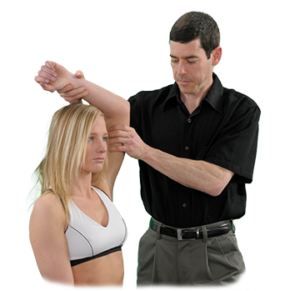Understanding Passive Range of Motion
- Whitney Lowe
Introduction to PROM
Passive range of motion (PROM) techniques are valuable tools for massage therapists working with musculoskeletal pain clients. Still, they are also helpful for those who do everyday care massage. PROM evaluations provide essential information about joint integrity, capsular restrictions, and tissue extensibility, which may not be apparent during active range of motion assessment alone. By systematically applying PROM techniques and interpreting the findings, practitioners can develop targeted treatment plans, monitor progress, and modify interventions.
Furthermore, incorporating PROM assessments after determining pain-free active motion can streamline the examination process without compromising the quality of care. Ultimately, the effective use of PROM techniques enables massage therapists to make informed decisions, optimize client outcomes, and enhance the overall efficiency of their practice.
Despite medical technology advancements, Passive Range of Motion (PROM) evaluations remain crucial to clinical assessments. These evaluations provide valuable insights into soft tissue function in locomotion that cannot be easily obtained through high-tech diagnostic procedures. PROM assessments focus on evaluating the movement of inert (vs contractile) tissues, such as joint capsules and ligaments, and can help identify pathological limitations to movement.
Performing PROM Evaluations
To perform a PROM evaluation effectively, it is essential to follow a step-by-step process. Before beginning the movement tests, ensure the client is as relaxed as possible, with significant muscular relaxation. This relaxed state will improve the accuracy of the evaluation by minimizing the influence of muscular effort. Tools like goniometers can measure joint angles during PROM assessments, providing objective data to support clinical findings. However, they are not essential for you to get valuable clinical information from your examination.
It is generally advised to conduct PROM evaluations after assessing active movements for optimal time efficiency. If a person has full, pain-free active movement, it is unlikely there would be pain with passive motion in the same direction. The reason is that the same passive movement only reduces muscular involvement. So, if there is no pain when the muscles are recruited, and then you do the same movement with no muscle action, it is unlikely there would be any pain with that movement. Therefore, it may not be necessary to conduct that specific passive movement evaluation. Performing the tests in this sequence will significantly expedite your assessment.
Understanding End-Feels in PROM
One of the most important factors to investigate during PROM testing is the end feel, which is the quality of movement perceived by the practitioner at the end of the range of motion. The end-feel can provide valuable information about the nature of various pathologies. There are six commonly used end-feel descriptions:
- Bone to bone: Motion is stopped by two bones contacting each other. This is the normal end feel at the end of elbow extension when the olecranon process of the ulna contacts the olecranon fossa of the humerus.
- Muscle spasm: When muscles are in spasm, they may abruptly halt motion before the usual endpoint, causing pain due to stretching the spasming muscle(s). This end feel usually has pain associated with it and a moderately firm stopping point well short of full range.
- Capsular or Tissue Stretch: Motion is limited at the end range by the joint capsule or other soft tissue becoming taut, e.g., external shoulder rotation. This end feel is often described as “leathery.”
- Springy block: Motion stops short of the expected range, often due to loose cartilage blocking full motion, e.g., the meniscus in the knee. End feel is usually a rubbery or springy feeling at the end.
- Tissue approximation: Motion stops due to two masses of soft tissue pressing on each other, e.g., elbow flexion. This end feel is felt at the end of elbow or knee flexion.
- Empty: The end of the range is not mechanically limited, but pain prevents the client from further movement.
Conclusion
Passive Range of Motion evaluations remain an essential tool for assessing soft tissue function and identifying pathological limitations to movement. By understanding the different types of end feels and treatment applications, clinicians can derive valuable information to guide treatment plans and effectively address their clients’ pain and injury conditions.
You can learn more about applying PROM evaluation and treatment strategies in our comprehensive Orthopedic Medical Massage Certificate Program.


